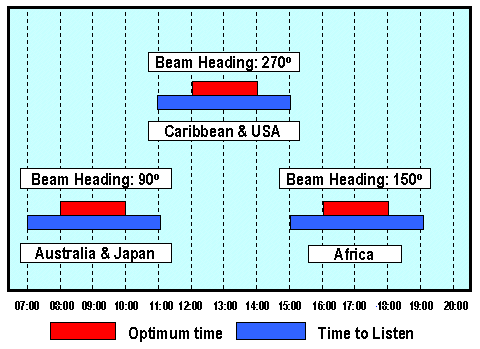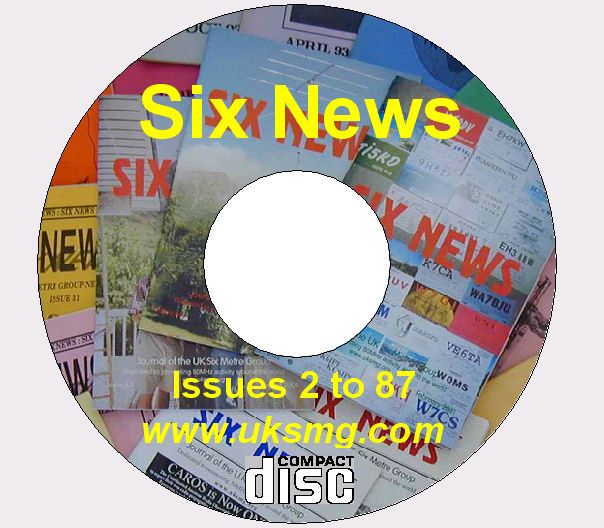|
Looking through the mail to the UK Six Metre Group for the last year it
seems that there are a lot of newcomers to six. Questions asked inevitably seem to be
centred on variants of "How and where can I hear all this DX, all I seem to hear is
noise?". To answer this question I thought that it might be a good idea to briefly
review the 1989 F2 season which could provide a few indicators as to when, and where, to
listen this autumn.

The
Lazy Person's Guide to F2DX
But before I do this, lets understand what is really needed to work good DX on
six metres. It has nothing to do with running high power, but it has everything to do with
commitment. What makes six metres so interesting and addictive is that real DX is mostly
very elusive, typified by either very short openings and/or weak fluttery signals.
Sometimes signals are strong like KG6DX who was 59+ on the morning of Friday 6th March ,
but if you are not in your shack, not pointing your aerial in the right direction, not
sure what is at the bottom of that pile-up, not sure what the hell is going on, or simply
joining the pile-ups much too late, your chances of working the DX reduces considerably.
Of course, only you can judge what time you put into the band and still meet your other
commitments of family, work and social life. But if you really want to rack the countries
up on six then you must put the time in listening to the white noise. Unfortunate, but
true. This does not mean sitting in front of the transceiver day-in, day-out, although it
can certainly mean just that at peak propagation periods. What it means is this: having
the rig on all the time; having the rig in the house, not in the shed at the bottom of the
garden; making a dash as soon as you hear something 'interesting'; not getting too
engrossed in a film to miss that short five-minute opening; it means getting your better
half to listen during the day and ringing you at work to hear what's on; finding out the
exact time of mid-week opening so that you are listening at the right time at weekends;
finding other local 6M enthusiasts and telephoning each other when something comes up;
getting onto the DXcluster; and careful planning of holidays to avoid missing active
periods. Need I go on? Of course, none of us should allow our hobby to dominate our lives
but of all the bands six metres needs the most time and effort to reap the benefits. You
cannot plan days off work and expect to work DX, (if you do sometimes you will be lucky!).
But the message is clear, to make the best use of the band you need as much help as you
can get to avoid having to listen to white noise for hours on an end - communicate.
Sometimes the 'phone is more active than six!
Commitment is one thing, experience is the other. It is no good being committed if you are
not aware of what is happening. Knowing what to listen for is mandatory if you are not
miss the one and only chance of working that DXpedition. Subscribe to newsletters,
SIXNEWS, KA3B (now edited by NI6E) newsletter, RSGB's 6M & UP DX'er, read RadCom, read
Practical Wireless, and so on (and now the Internet of course!).
Listen on 28.885 and 3.718 for who's where and when. Listen to the gossip and rumour and
be prepared! Always try and find out the facts - when, where, times of operation, beacons, callsigns etc . Every bit of information helps.
So what about when and where to listen this autumn? There are no certainties but we can
use the 1989 season's experience to minimise the chance of missing DX. The first major
openings to VK8 (for me) occurred for me on the 13th October 1989. This opening typified
all following openings to Oceana/Asia. They all start early morning, peaking at 0852z.
Very rarely they start earlier and sometimes they can go onto 1200z, but 0900z is the best
time to listen. Beam headings are usually non-great circle but I would suggest that a
heading of 60 degrees be used as a starter. Headings vary between 30 and 129 degrees. The
first thing to listen for is strong video coming up from the LF part of the band. This
could be from Russian or Chinese television. At the same time listen on 28.885 for VK or
JA stations saying that they have propagation to Europe (note who's listening at the
'other end'). Most times DX will be heard in Scandinavia or Holland before it opens up to
the UK. Listen out on 6M for backscatter from European stations calling to the east. Try
and grab, callsigns and frequencies to be prepared for when the propagation moves to the
UK. Try and get the DX before the pile-ups start! During the month of October 1989 and
early November, Australia, Hong Kong, Japan, Guam and the Philippines were worked during
this style of F2 opening. It really was a momentous month, but little did we know what
November held in store for us!
Early November brought back the midday openings to east-coast USA and Equador with the
usual well-known callsigns - VE1YX, VO1MP, W3EP and HC5K coming through etc. These usually
started at 1130z on a beam heading of 280 degrees. Then at 1200z on 11th November 9Y4VU
was heard at 59+. This was the beginning of fantastic openings virtually every day to the
Caribbean, South America and the USA lasting through to Christmas. Beam headings were
between 240 and 300 degrees with most of the openings starting late morning. I managed to
get some lunchtimes off and found that the magic time was 1250z. Some of the countries,
heard and worked were FY (FY5AU!), 9Y, P43, PZ, ZF, KG4, OA8, KP4, HH7, YV, PJ9, VP9, VP2,
VP5, V47, HI8, HK, V31, V29 etc. These big openings to the Caribbean were not repeated in
1990 - but it could happen again this autumn.
So there we are. During the autumn of 1989 there was something for everybody. You couldn't
fail to work some or other exotic countries - even by HF standards. But at the end of the
day it still came down to listening and being alert, ready and waiting for the next
expected DX. Let us hope that this autumn is just as good. I would expect that by the time
you have read this article we would have had the first of this season's openings to VK.
Good luck - I expect to here you all in the pileups and getting just as frustrated as me -
just like smoking isn't it?
UKSMG Six News
issue 31,
October
1991
|
|



